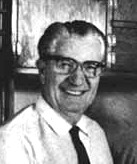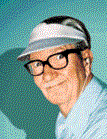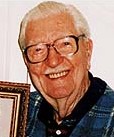1940s
On the 1941 strike at
Disney's:
Well, I was in the story department and we
didn't strike. The animators and in-betweeners
were the ones on strike. We in the story
department went through the picket line every
morning. I was against the strike. I had the
feeling that something was being destroyed. The
Disney studios were a place where there were no
time clocks - we were able to come to work
whenever we wanted to. If you went to work, did a
good job and had something to show for your
efforts, you got paid damn well. If you were
shirking and complaining all the time you didn't
get a raise, and it was these shirkers and
complainers who had organized this strike. Disney
was fair - of course, he could have been more
considerate and humane to his employees, but
those were hard times. He brought a bunch of us,
who, if we were lucky, could earn 10 dollars a
week doing whatever job - and he gave us twenty.
I know many who were not grateful to him for that.
They thought that if a Disney film brings in 100,
000 dollars, they should get half of it. But Walt
invested the entire amount in order to make a new
film.
On other Disney characters:
Goofy was simply a half-wit. I could never
understand what was supposed to be funny about a
half-wit. I liked Mickey for his purposes. He was
good in adventure-strips. But the thought of
having to draw something like this did not appeal
to me. I enjoyed working with the duck because I
could knock him around, have him get hurt - I
could let him fall off cliffs. It was lots of fun
with Donald. With Mickey it would have been kind
of dangerous, because Mickey always had to be
right. With the duck I had a comedian that I
could treat badly and who I could make fun of.
Before
leaving Disney and plunging into comic book work,
Barks had actually participated in a story with
the ongoing war as the main topic:
'Pluto
Saves the Ship' was written by Jack Hannah, Nick
George, and I in 1942 in our evening hours. It
was not an adaptation of a cartoon story. Eleanor
Packer of Whitman Publishing may have dreamed up
the basic plot. It was only a one-shot special
designed to take advantage of the wartime jitters.
Anyway, we three did the final draft in rough
sketch form in my den room in North Hollywood.
The post-Pearl Harbor blackouts were in effect,
and we had all window blinds closed and taped
shut. It was hot and stuffy, and we consumed many
beers. The story shows the effects. One of Disney's
layout men with a flair for drawing panel after
panel of shipyard scaffolding did the artwork.
Barks
officially moved from Burbank to San Jacinto a
few days before his resignation in order to start
as a chicken farmer. He had actually bought the
place a couple of years earlier, but kept the
purchase a secret:
I left the
Disney Studios in November 1942 because I was in
poor health and had to leave. I had found that
the hot sunshine of the desert areas east of Los
Angeles cleared up my allergies. It was a
reckless gamble to leave a 100 dollars a week for
the fragile security of a chicken farm, but I
hoped to get into comic book work on a freelance
basis as a sideline occupation.
Choosing chickens was a matter of economics. I
mean, I didn't care much for chicken farming. I
wouldn't have gone into the dairy business, for
instance, because that is really tying you down.
You've got to milk cows at a certain hour of
every day. With chickens you're pretty much tied
down, too, but you needn't be there at a specific
hour to get the eggs. You can leave them to lie
there until the next day and gather them up. It
doesn't cost very much to go into raising a few
chickens, but going into any other type of
farming is very expensive.
Margaret Williams, who
already from her school years was known as Garé,
first met Carl briefly in 1942:
She had seen a newspaper article about a
nearby chicken farmer who dabbled with the
drawing of some comic books and she went out
there to see if he might have any work for her.
Little did she know that she met her future
husband that day, because the farmer was Carl
Barks:
She came over to see me at a time when my second
wife and I were in San Jacinto. I was drawing the
comic books and a little article had been printed
about me in the newspaper, about how I was
working on duck comic strips, and I guess Garé
had heard about it, and she thought, maybe I
might have some work that she could help out. She
was a graduate of art school in Boston and she
needed some kind of employment, so she could use
some of her talent.
She came over and talked and asked about it. I
thought it all over, and I thought, well, do I
want to take on the responsibility of an
assistant, and how much work could I provide for
this girl, if I did? And so I handed her a bunch
of duck model sheets and told her to practice on
those and see what she could do in the way of
inking and so on. She tried it out and let me
know that she found it much too difficult.
Shortly after that she got a job down at
McDonnell Douglas, where they were building
airplanes. The war was on, and she was in the
drafting department, lettering the drafting pages.
On Alex Raymond (Flash
Gordon):
There was a man who could combine
craftsmanship with emotions and all the gimmicks
that went into a good adventure strip. He was a
master.
I could just sit there and look at the drawings
and be inspired. Of course, I couldn't use those
drawings very much in doing the duck stories
later on, except for the background or the
atmosphere of the places the ducks had to go.
That inspired me to do some nice drawings in
there, and it helped to put those duck stories
over and make them popular. Because they appeared
to go to real places.
At the start of his career
Barks often gave precise instructions as to which
colours should be used in special circumstances
but Western just did what they pleased. So Barks
gave up:
If I asked for a yellow desert, you could be
sure it turned out red.
On giving that little extra
to the stories:
If you have a story to tell, a story that
somebody is going to read over and over again,
you have to put some substance into it. It takes
more than just a bunch of pratfalls and bumps on
the head. There had to be motivation for the
different things the characters did, and revenge
for their mistakes (laughs). It took a
lot to write a ten-page story. A lot of the guys
didn't take the time to go into it that far and
as a result there were a lot of the comic book
stories that never lasted for very long. With my
stories, because I worked so hard to make the
story plausible and give it a reason for having
been written, people would read it over and over
again. They didn't throw the comic book away. So
these stories are still alive today, while many
others are gone and forgotten.
|




